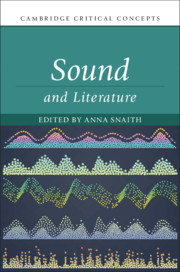Book contents
- Sound and Literature
- Cambridge Critical Concepts
- Sound and Literature
- Copyright page
- Epigraph
- Contents
- Figures
- Contributors
- Acknowledgements
- Introduction
- Part I Origins
- Part II Development
- Part III Applications
- Chapter 10 What We Talk about When We Talk about Talking Books
- Chapter 11 Prose Sense and Its Soundings
- Chapter 12 Dissonant Prosody
- Chapter 13 Deafness and Sound
- Chapter 14 Vibrations
- Chapter 15 Feminism and Sound
- Chapter 16 Wireless Imaginations
- Chapter 17 Attending to Theatre Sound Studies and Complicité’s The Encounter
- Chapter 18 Bob Dylan and Sound: A Tale of the Recording Era
- Bibliography
- Index
Chapter 10 - What We Talk about When We Talk about Talking Books
from Part III - Applications
Published online by Cambridge University Press: 29 May 2020
- Sound and Literature
- Cambridge Critical Concepts
- Sound and Literature
- Copyright page
- Epigraph
- Contents
- Figures
- Contributors
- Acknowledgements
- Introduction
- Part I Origins
- Part II Development
- Part III Applications
- Chapter 10 What We Talk about When We Talk about Talking Books
- Chapter 11 Prose Sense and Its Soundings
- Chapter 12 Dissonant Prosody
- Chapter 13 Deafness and Sound
- Chapter 14 Vibrations
- Chapter 15 Feminism and Sound
- Chapter 16 Wireless Imaginations
- Chapter 17 Attending to Theatre Sound Studies and Complicité’s The Encounter
- Chapter 18 Bob Dylan and Sound: A Tale of the Recording Era
- Bibliography
- Index
Summary
In seeking to frame reading as a multimedia event, this chapter looks back to a period in the late nineteenth century when book-makers sought in various ways to refashion their products as audiobooks, and so to undo some of the principles that characterise silent reading. In this way, the chapter elaborates on the familiar history of gramophonic storage media by uncovering a pre-history that stretches right back to the technology of Thomas Edison in the 1870s. This, then, is an experiment in media archaeology, which is alive both to forgotten and aborted attempts to make books talk, and to books that like to imagine in more vicarious ways a reading culture unencumbered by the false principles of an ‘audiovisual litany’, as Jonathan Sterne once put it. The chapter touches on a variety of material – by Edward Bellamy and Bram Stoker, and by the French science fiction writers Albert Robida and Jules Verne – and it does so with a view to showing how imaginative writers anticipated the future of sound media.
- Type
- Chapter
- Information
- Sound and Literature , pp. 211 - 233Publisher: Cambridge University PressPrint publication year: 2020



